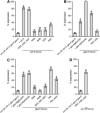Noncell- and cell-autonomous G-protein-signaling converges with Ca2+/mitogen-activated protein kinase signaling to regulate str-2 receptor gene expression in Caenorhabditis elegans
- PMID: 16868120
- PMCID: PMC1526693
- DOI: 10.1534/genetics.106.058750
Noncell- and cell-autonomous G-protein-signaling converges with Ca2+/mitogen-activated protein kinase signaling to regulate str-2 receptor gene expression in Caenorhabditis elegans
Abstract
In the sensory system of C. elegans, the candidate odorant receptor gene str-2 is strongly expressed in one of the two AWC neurons and weakly in both ASI neurons. Asymmetric AWC expression results from suppression of str-2 expression by a Ca2+/MAPK signaling pathway in one of the AWC neurons early in development. Here we show that the same Ca2+/MAPK pathway promotes str-2 expression in the AWC and ASI neurons together with multiple cell-autonomous and noncell-autonomous G-protein-signaling pathways. In first-stage larvae and adult animals, signals mediated by the Galpha subunits ODR-3, GPA-2, GPA-5, and GPA-6 and a Ca2+/MAPK pathway involving the Ca2+ channel subunit UNC-36, the CaMKII UNC-43, and the MAPKK kinase NSY-1 induce strong str-2 expression. Cell-specific rescue experiments suggest that ODR-3 and the Ca2+/MAPK genes function in the AWC neurons, but that GPA-5 and GPA-6 function in the AWA and ADL neurons, respectively. In Dauer larvae, the same network of genes promotes strong str-2 expression in the ASI neurons, but ODR-3 functions in AWB and ASH and GPA-6 in AWB. Our results reveal a complex signaling network, encompassing signals from multiple cells, that controls the level of receptor gene expression at different developmental stages.
Figures






Similar articles
-
A network of stimulatory and inhibitory Galpha-subunits regulates olfaction in Caenorhabditis elegans.Genetics. 2004 Aug;167(4):1677-87. doi: 10.1534/genetics.103.024786. Genetics. 2004. PMID: 15342507 Free PMC article.
-
A Toll-interleukin 1 repeat protein at the synapse specifies asymmetric odorant receptor expression via ASK1 MAPKKK signaling.Genes Dev. 2005 Jan 15;19(2):270-81. doi: 10.1101/gad.1276505. Epub 2004 Dec 29. Genes Dev. 2005. PMID: 15625192 Free PMC article.
-
SEK-1 MAPKK mediates Ca2+ signaling to determine neuronal asymmetric development in Caenorhabditis elegans.EMBO Rep. 2002 Jan;3(1):56-62. doi: 10.1093/embo-reports/kvf001. Epub 2001 Dec 19. EMBO Rep. 2002. PMID: 11751572 Free PMC article.
-
Heterotrimeric G proteins in C. elegans.WormBook. 2006 Oct 13:1-25. doi: 10.1895/wormbook.1.75.1. WormBook. 2006. PMID: 18050432 Free PMC article. Review.
-
Stochastic left-right neuronal asymmetry in Caenorhabditis elegans.Philos Trans R Soc Lond B Biol Sci. 2016 Dec 19;371(1710):20150407. doi: 10.1098/rstb.2015.0407. Philos Trans R Soc Lond B Biol Sci. 2016. PMID: 27821536 Free PMC article. Review.
Cited by
-
Generation and modulation of chemosensory behaviors in C. elegans.Pflugers Arch. 2007 Aug;454(5):721-34. doi: 10.1007/s00424-006-0196-9. Epub 2007 Jan 6. Pflugers Arch. 2007. PMID: 17206445 Review.
-
Comparative functional analysis of the Caenorhabditis elegans and Drosophila melanogaster proteomes.PLoS Biol. 2009 Mar 3;7(3):e48. doi: 10.1371/journal.pbio.1000048. PLoS Biol. 2009. PMID: 19260763 Free PMC article.
-
Dauer Formation in C. elegans Is Modulated through AWC and ASI-Dependent Chemosensation.eNeuro. 2021 Apr 14;8(2):ENEURO.0473-20.2021. doi: 10.1523/ENEURO.0473-20.2021. Print 2021 Mar-Apr. eNeuro. 2021. PMID: 33712439 Free PMC article.
-
Transcriptional regulation and stabilization of left-right neuronal identity in C. elegans.Genes Dev. 2009 Feb 1;23(3):345-58. doi: 10.1101/gad.1763509. Genes Dev. 2009. PMID: 19204119 Free PMC article.
-
The homeodomain protein hmbx-1 maintains asymmetric gene expression in adult C. elegans olfactory neurons.Genes Dev. 2010 Aug 15;24(16):1802-15. doi: 10.1101/gad.1932610. Genes Dev. 2010. PMID: 20713521 Free PMC article.
References
-
- Bargmann, C. I., 1998. Neurobiology of the Caenorhabditis elegans genome. Science 282: 2028–2033. - PubMed
-
- Bargmann, C. I., and I. Mori, 1997. Chemotaxis and thermotaxis, pp 717–737 in C. elegans II, edited by D. S. Riddle, T. Blumenthal, B. J. Meyer and J. R. Priess. Cold Spring Harbor Laboratory Press, Cold Spring Harbor, NY. - PubMed
Publication types
MeSH terms
Substances
LinkOut - more resources
Full Text Sources
Research Materials
Miscellaneous

